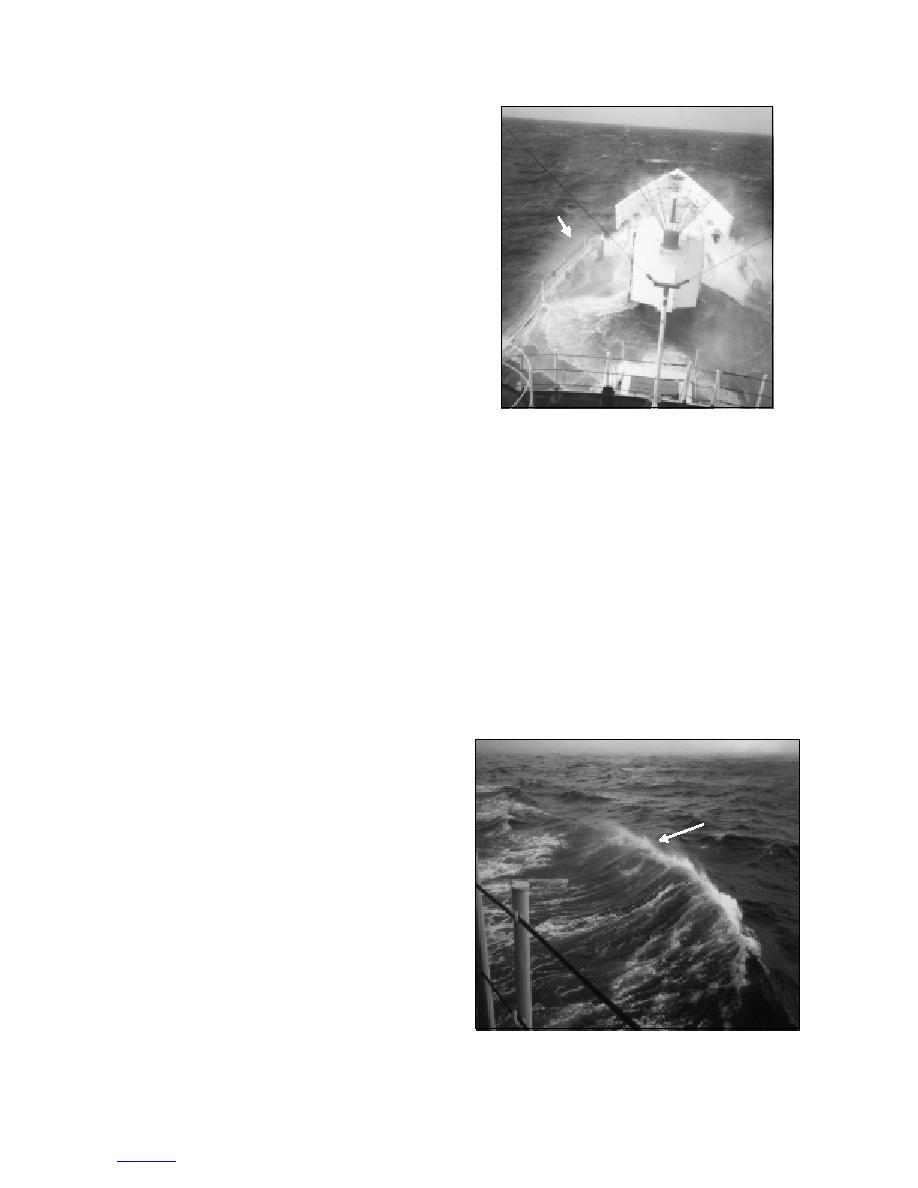
atmospheric conditions such as relative wind speed and
direction, change. Thus, it is conceivable that ice may
be growing on some portions of the superstructure,
while on other areas it may be eroding (Ryerson 1995).
In addition, depending upon ship size, spray delivery
Deck
rates, and atmospheric conditions, only one, two, or all
spray
three of the zones may be found at any one time on the
ship. Often, however, thermally limited accretion
occurs in the bow area, transitioning to maximum, and
mass limited, accretion zones at higher levels and far-
ther aft. The freezing fraction, as defined by the por-
tion of impinging spray water that remains trapped in
ice on the superstructure, also increases with distance
aft of the bow and with height above the water (Fig. 1).
The size and design of a ship also have other effects
upon the rate of superstructure spraying during icing
conditions, and the subsequent growth of topside ice.
Smaller vessels are immersed with spray more fre-
Figure 3. Deck spray created from water
quently than larger ships because of their lower free-
escaping over deck edge and through
board and greater heave frequency. Also, bow spray
scuppers. This is a secondary source
clouds are more likely to cover the entire superstruc-
of spray causing superstructure icing.
ture of a small ship with a large spray flux. Larger ves-
sels create spray less frequently because of their smaller
heave frequency and rate, and larger freeboard. In ad-
dition, bow spray clouds are less likely to cover all of a
measurements of superstructure spray and ice aboard
large vessel. Therefore, only a portion of the entire ship
the United States Coast Guard cutter Midgett in the
is likely to ice heavily, resulting in less rapid overall
Bering Sea during February and March 1990. The
accretion rates and less threatening accretions. Finally,
USCGC Midgett (Fig. 5) is not as large as a typical
the shape of the vessel's hull determines the amount of
Navy destroyer or cruiser at 378 ft (115 m) and 2980
spray lofted over the superstructure. Ships with greater
tons (2703 tonnes) displacement, but our measurements
freeboard in the bow area and greater bow rake or flare
were intended to characterize spray and ice conditions
will tend to deflect spray away from themselves, and
that might occur on a U.S. Navy ship. The size and sea-
reduce entrainment of drops into the relative wind
keeping ability of the cutter were certainly more repre-
(Sapone 1990).
Though bow spray generates the most liquid water
content, secondary spray also results when water accu-
mulated on decks drains over the edge or through scup-
pers. It also results from spume fountains. In the former
situation, wind moving up the side of the flared bow
Spume
entrains water draining from the decks, creating a sec-
fountains
ondary spray event that follows the primary event by a
few seconds. This secondary spray event prolongs to-
tal spraying but has small liquid water content (Fig. 3).
Light spray also originates along the windward sides
of ships in moderate or larger seas from interaction of
the bow wave with natural waves, causing breakers and
"spume fountains" (Fig. 4). Spume occurs only where
the bow wave and natural waves meet, causing them to
break, which happens at an increasing distance from
the ship with distance aft of the bow, creating a light
mist along the sides of the ship.
Figure 4. Spume fountains on the port side of
Research cruise
USCGC Midgett, a secondary source of spray.
CRREL was contracted by the U.S. Navy to make
3
to contents



 Previous Page
Previous Page
